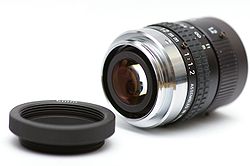- C mount
-
 12 mm f/1.2 C-Mount lens with a C-Mount to CS-Mount adapter
12 mm f/1.2 C-Mount lens with a C-Mount to CS-Mount adapter
A C mount is a type of lens mount commonly found on 16mm movie cameras, closed-circuit television cameras, and trinocular microscope phototubes.
C-mount lenses provide a male thread which mates with a female thread on the camera. The thread is nominally 1.000 inch (25.4 mm) in diameter, with 32 threads per inch, designated as "1-32 UN 2A" in the ANSI B1.1 standard for unified screw threads. The flange focal distance is 17.526 millimetres (0.6900 in) for a C mount.
Merely to say that a lens is "C-mount" says very little about the lens' intended use. Unlike all other lens mounts, each of which is used for only a single format, C-mount lenses have been made for many different formats, the largest being 4 times as large as the smallest. The vast majority of C-mount lenses are built for the 8-mm and 16-mm film formats and the 1/3-, 1/2-, 2/3-, and 1-inch video formats, which corresponds to a range of image circles from 5 to 17 mm diameter, approximately. Some manufacturers have recently introduced lenses for the 4/3 inch / 1.3 inch format but these remain very expensive.
This is no trivial difference. For example, for the 4/3 format, a 12-mm lens is a wide-angle lens and will have a retrofocus design. For the 2/3 inch format, a 12mm lens is "normal" and can have a simple and fast double Gauss layout. For the 1/3 inch format, a 12-mm lens is long and can have a telephoto design.
Some TV lenses lack provision to focus or set exposure, so may not operate properly with film cameras. Also, some TV lenses may have bits that protrude behind the mount far enough to interfere with the shutter or reflex finder mechanisms of a film camera.
Although C-mount lenses have a back focal distance far too short to be used with 35mm film SLRs or any existing digital SLR, they can be mounted on interchangeable-lens mirrorless digital cameras. One such system is the Micro Four Thirds, being used by Olympus and Panasonic. However, the vast majority of C-mount lenses produce an image circle too small to light up the entire (micro-)four-thirds sensor, with its approximately 22-mm diagonal. This produces what is popularly called "vignetting" but is better described as a mismatch between camera format and lens format.[1]
The letter "C" is said to stand for "cine", the original application being movie camera lenses.
Contents
CS mount
CS-mount has a flange focal distance of 12.50 millimetres (0.492 in), but is otherwise the same as C-mount, including the fact that lenses for many different formats are made for it. CS-mount lenses are built for the smaller formats, 1/2 inch and down.
Combinations: C, CS and extension adapter Camera
bodyextension
tube
adapterLens Net
EffectFocus View
angleZoom Exposure C C Normal Normal Normal Normal C CS +5mm Near-sighted Narrower Larger Darker C 5.0 millimetres (0.20 in) C +5mm Near-sighted Narrower Larger Darker C 5.0 millimetres (0.20 in) CS +10mm Most Near-sighted Narrowest Largest Darkest CS C -5mm Far-sighted Wider Smaller Brighter CS CS Normal Normal Normal Normal CS 5.0 millimetres (0.20 in) C Normal Normal Normal Normal CS 5.0 millimetres (0.20 in) CS +5mm Near-sighted Narrower Larger Darker See also
References
- ISO 10935:1996, "Optics and optical instruments -- Microscopes -- Interfacing connection type C"
External links
- Making Digital Camera Microscope Adapters. The section "Understanding C-Mount and CS-Mount Standard Mechanics, Optics, and Cameras" discusses the standards and custom machining of C-mount apparatus.
- List of some C-mount lenses. Collection of cine optics and photos of them.
Categories:- Filmmaking stubs
- Lens mounts
- Film and video technology
Wikimedia Foundation. 2010.
